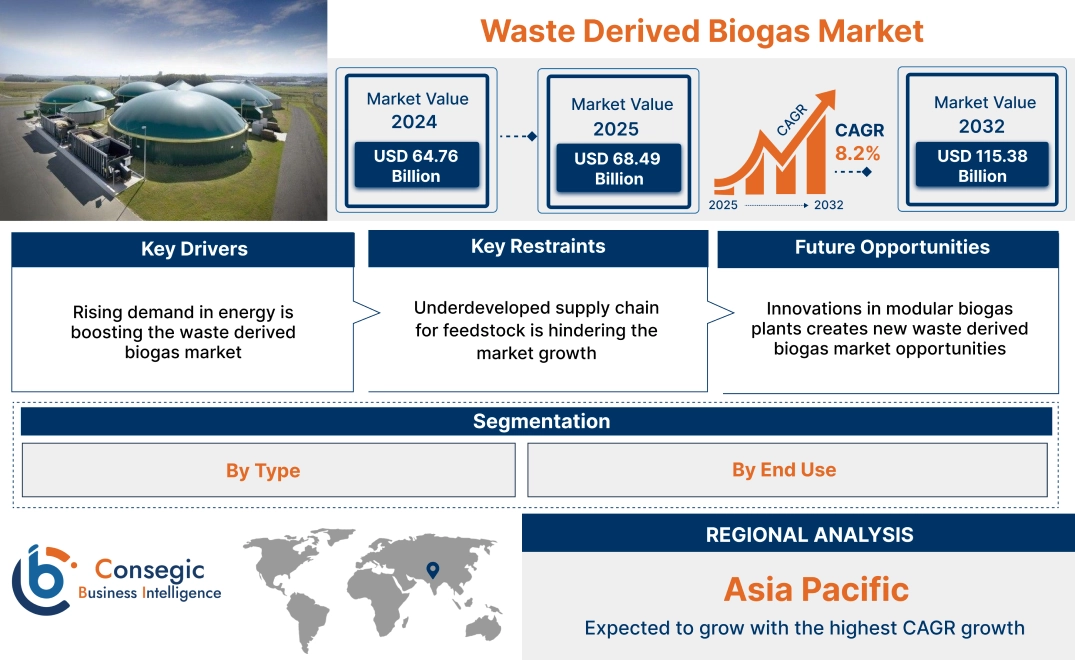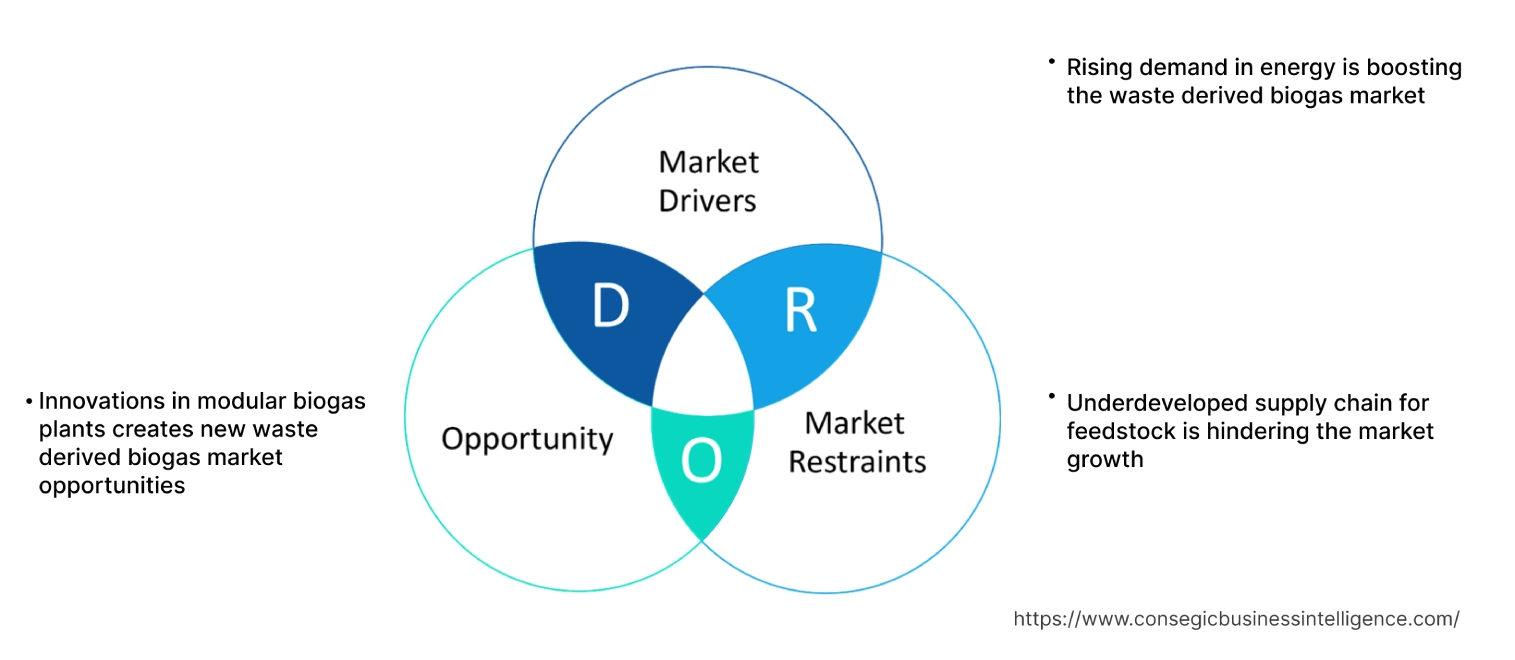- Summary
- Table Of Content
- Methodology
Waste Derived Biogas Market Size:
Waste Derived Biogas Market size is estimated to reach over USD 115.38 Billion by 2032 from a value of USD 64.76 Billion in 2024 and is projected to grow by USD 68.49 Billion in 2025, growing at a CAGR of 8.2% from 2025 to 2032.
Waste Derived Biogas Market Scope & Overview:
Biogas can be derived from waste through a process called anaerobic digestion, in which microorganisms break down organic matter in the absence of oxygen. The decomposition leads to production of biogas, and the remaining material is used as a fertilizer. Moreover, biogas production using waste reduced waste, generates power, and produces fertilizer. Biogas also provides several benefits including reduced greenhouse gas emissions, improved waste management, reduced soil pollution, and improved sanitation among others.
Key Drivers:
Rising demand in energy is boosting the waste derived biogas market
The global economies are experiencing a surge in energy demand due to increased global temperature that leads to excessive usage of cooling appliances. Moreover, increased penetration of electric vehicles and consumer electronics leads to amplified usage of electricity. Furthermore, rising number of data centers and IT services leads to increased usage of electric power. The rising energy demand requires sustainable energy production methodology, leading to increasing adoption of waste derived biogas manufacturing plants.
- For instance, in March 2025, International Energy Agency stated that the global energy demand increased by 2.2% in 2024. The developing economies accounted for more than 80% increase in the global energy demand.
Thus, the aforementioned factors are boosting the applications of energy sources including biogas, in turn driving the waste derived biogas market growth.
Key Restraints:
Underdeveloped supply chain for feedstock is hindering the market growth
Biogas production plants require sufficient water and substrate supply for optimized operation and function. The availability of sufficient substrate in rural regions is challenging along with the insufficient water capacity in many regions around the globe. The insufficient resources leads to reduced yield or formation of scum, making the biogas production plants non-functional.
Moreover, lack of collaboration in governments and project developers also leads to inconsistent supply of raw materials, in turn, hampering the production. Thus, the market analysis shows that the aforementioned factors are restraining the waste derived biogas market demand.
Future Opportunities :
Innovations in modular biogas plants creates new waste derived biogas market opportunities
The modular biogas plants are built using prefabricated models that are easy to deploy and transport. Modular biogas plants can be scaled up or down as per the requirement, making them suitable for various applications. The prefabricated design makes it easier to transport and installation in remote locations. Moreover, these biogas plants are suitable for small communities, agricultural operations, and residential use.
- For instance, in October 2024, Tata Steel UISL launched an initiative to manage biodegradable waste in Jamshedpur. The initiative aims to install modular biogas plants in the city for minimizing the ecological footprint associated with waste transportation and decentralizing the management of municipal solid waste.
Thus, the rising innovations in biogas plants are projected to drive waste derived biogas market opportunities during the forecast period.
Waste Derived Biogas Market Segmental Analysis :
By Type:
Based on the type, the market is segmented into landfill gas, agricultural waste, sewage, and industrial wastewater.
Trends in the Type:
- Rising need for efficient management of industrial wastewater leads to usage of biogas plants, in turn boosting the waste derived biogas market size.
- Increasing trend in adoption of landfill waste to produce landfill gas and reduce waste and emissions is driving the market growth.
The agricultural waste segment accounted for the largest revenue share of 51.83% in the waste derived biogas market share in 2024.
- Biogas plants transform agricultural waste including manure and crop residues into biogas and fertilizers, reducing the environmental burden of agricultural activities and preventing pollution.
- Moreover, proper manure management through biogas production helps prevent runoff of pollutants into waterways, protecting water quality.
- For instance, according to American Biogas Council, USD 711.8 million was invested in agricultural waste bio gas plants in the U.S in 2023. Moreover, the agricultural waste accounted for 32% of the biogas production facility in 2023.
- Therefore, the waste derived biogas market analysis depicts that the wide spread adoption of agricultural waste for production of biogas is boosting the waste derived biogas market growth.
The industrial wastewater segment is expected to register the fastest CAGR during the forecast period.
- Industrial waste, such as food processing residues, wastewater sludge, and agricultural byproducts, are fed into a biogas plant. Biogas plants help reduce greenhouse gas emissions, soil and water pollution, and the need for landfills.
- For instance, European Biogas Association stated that EBA-WG demonstrated that it is possible to recover about 14 Mtoe (142 TWh) of biogas per year by valorizing industrial wastewater.
- Thus, the market analysis depicts that the wide benefits provided by using industrial wastewater for biogas production is expected to boost the waste derived biogas market trends during the forecast period.
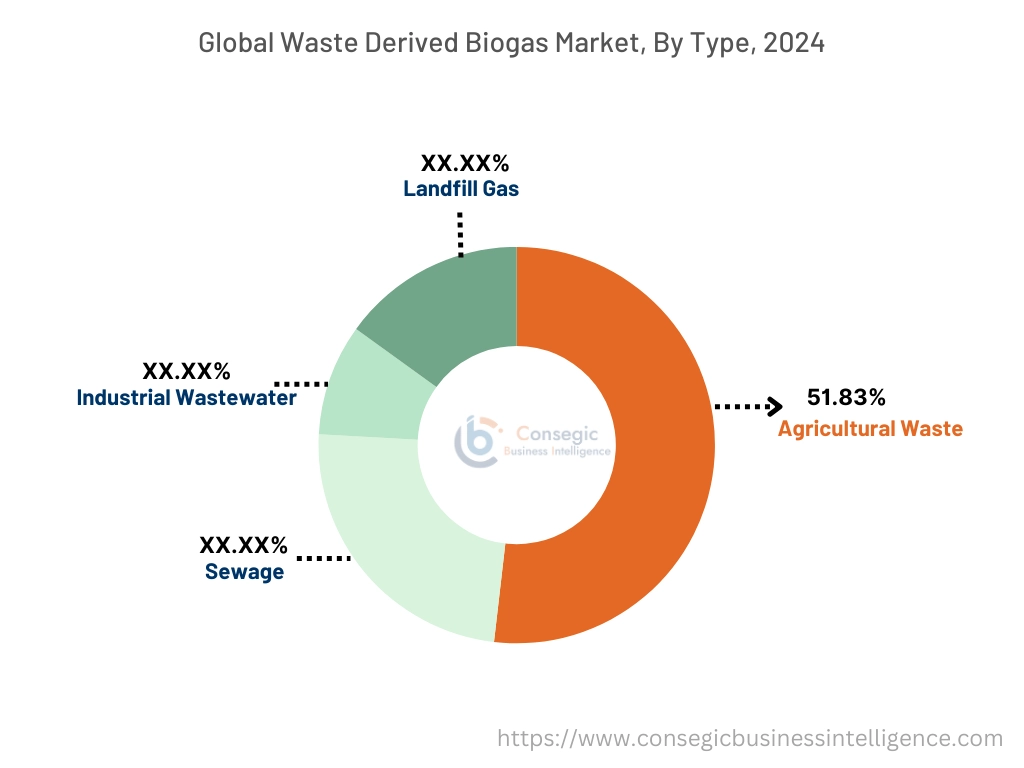
By End Use:
Based on the end use, the market is trifurcated into on-site electricity production, transportation fuel, and municipal electricity production.
Trends in the End Use:
- Rising trend in adoption of biogas as a transportation fuel due to reduce emissions and pollution in the environment.
- Increasing trend in adoption of biogas for municipal electricity production to reduce dependency on fossil fuels is boosting the waste derived biogas market size.
The on-site electricity production accounted for the largest revenue share in the waste derived biogas market share in 2024.
- On-site electricity production using biogas plants involves using biogas, a renewable fuel produced from the breakdown of organic matter, to generate electricity on-site, offering a sustainable and decentralized energy solution.
- For instance, according to International Energy Agency, Europe has 20,000 biogas plants, mostly located in Germany. Most of these plants are built for on-site electricity production and co-generation.
- Therefore, the benefits offered by on-site electricity production are boosting the waste derived biogas market demand.
The transportation fuel segment is expected to register the fastest CAGR during the forecast period.
- Biogas is often upgraded to biomethane or renewable natural gas by removing impurities including water, carbon dioxide, and hydrogen sulfide. The upgraded biogas is then used as a transportation fuel.
- Biogas as a transportation fuel offers several benefits including renewable energy source, reduced greenhouse gas emissions, and the potential for waste management solutions.
- For instance, International Energy Agency stated that there are around 28 million natural gas-fueled vehicles in the world. Moreover, India is expected to expand the use of biomethane in transport, targeting the buildout of 5,000 bio-CNG stations by 2025. This showcases the rising adoption of biogas as a transportation fuel.
- Therefore, the market trend analysis depicts that the aforementioned factors are expected to propel the waste derived biogas market trends during the forecast period.
Regional Analysis:
The regions covered are North America, Europe, Asia Pacific, the Middle East and Africa, and Latin America.
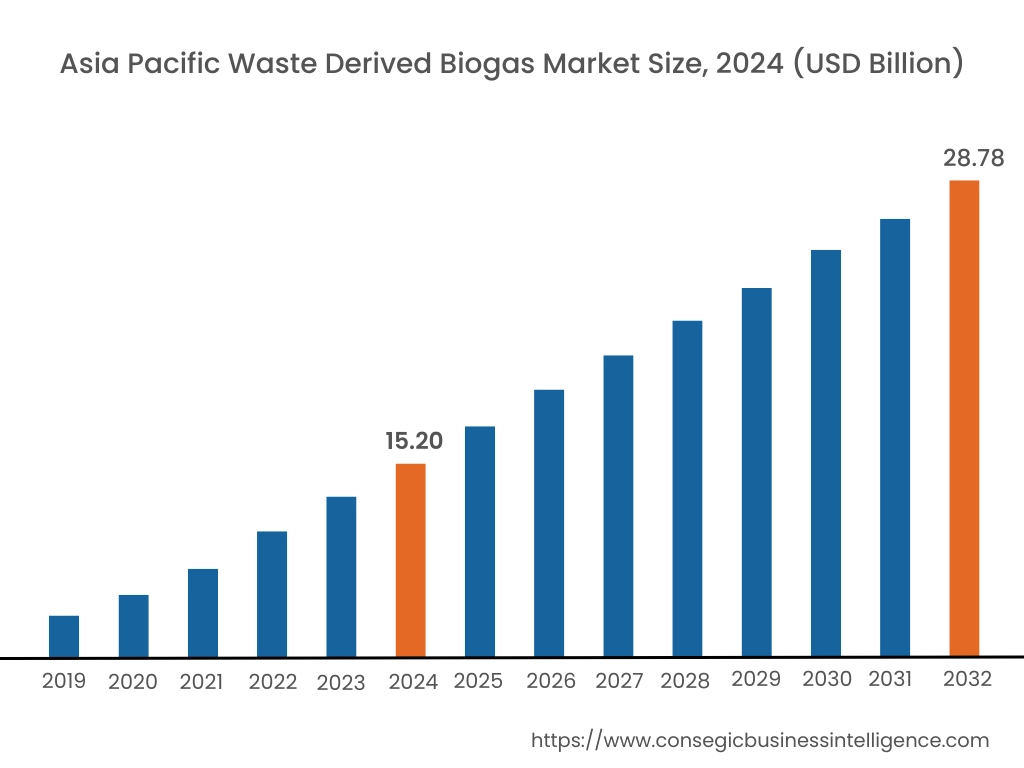
Asia Pacific region was valued at USD 15.20 Billion in 2024. Moreover, it is projected to grow by USD 16.16 Billion in 2025 and reach over USD 28.78 Billion by 2032. Out of this, China accounted for the maximum revenue share of 28.04%. The regional analysis states the market growth in the region is boosting due to rising government investments in biogas production, growing awareness about sustainability, increasing adoption of clean alternatives to fossil fuels, and others.
- For instance, according to the Government of India’s GOBARdhan portal, there were 872 operational biogas plants in 2024, with a minimum capacity of five cubic meters per day, while an additional 350 plants are under progress.
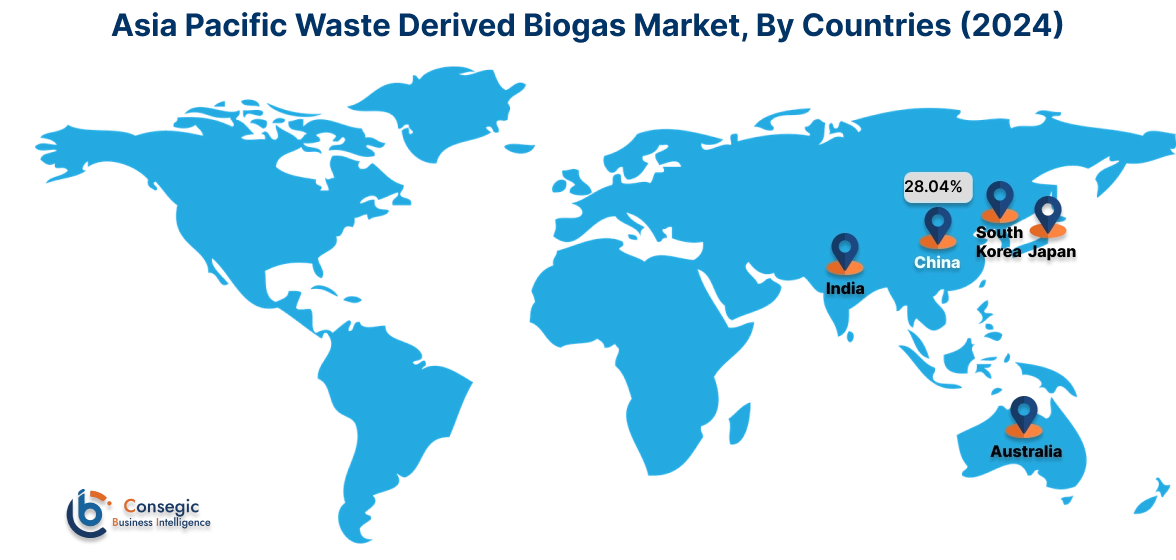
North America is estimated to reach over USD 31.61 Billion by 2032 from a value of USD 17.55 Billion in 2024 and is projected to grow by USD 18.58 Billion in 2025. The market growth in the region is proliferating due to government initiatives to promote biogas as a fuel, rising adoption of electric vehicles, and expanding IT industry that relies on electricity. Moreover, the ability of biogas to provide a cleaner and greener way to produce electricity is boosting the waste derived biogas market expansion.
- For instance, according to American Global Council, 96 new biogas plants became operational in the United States in 2023. This added up the total biogas plants count to 2,251, which represents USD 39 billion in capital investment.
In Europe, the market growth is driven by strict regulations by government for waste management, rising need for industrial waste water management, and greenhouse gas emissions, leading to adoption of clean energy options. The waste derived biogas market analysis shows that in Latin America, Middle East and Africa, factors such as rising awareness about benefits of biogas in various industries, and its ability to generate clean electricity while reducing emissions and pollution are propelling the waste derived biogas market expansion.
Top Key Players and Market Share Insights:
The waste derived biogas industry is highly competitive with major players providing solutions to the national and international markets. Key players are adopting several strategies in research and development (R&D), product innovation, and end-user launches to hold a strong position in the global waste derived biogas market. Key players in the waste derived biogas industry include -
- Cargill, Inc. (US)
- N-bio GmbH (Germany)
- AAT ABWASSER- UND ABFALLTECHNIK GMBH (Germany)
- Environmental Products & Technologies Corporation (US)
- Weltec Biopower GmbH (Germany)
- Zorg Biogas (Germany)
- BEKON GmbH (Germany)
- Siemens (Germany)
- BIOGEN Ltd. (UK)
- Evoqua Water Technologies LLC (US)
Recent Industry Developments :
Business Expansions:
- In October 2023, BP launched biogas plant in the U.S. The plant can process 3,200 cubic feet of landfill gas per minute (scfm) into RNG. This amount of gas is enough to heat around 13,026 homes annually.
Waste Derived Biogas Market Report Insights :
| Report Attributes | Report Details |
| Study Timeline | 2019-2032 |
| Market Size in 2032 | USD 115.38 Billion |
| CAGR (2025-2032) | 8.2% |
| By Type |
|
| By End Use |
|
| By Region |
|
| Key Players |
|
| North America | U.S. Canada Mexico |
| Europe | U.K. Germany France Spain Italy Russia Benelux Rest of Europe |
| APAC | China South Korea Japan India Australia ASEAN Rest of Asia-Pacific |
| Middle East and Africa | GCC Turkey South Africa Rest of MEA |
| LATAM | Brazil Argentina Chile Rest of LATAM |
| Report Coverage |
|
Key Questions Answered in the Report
How big is the waste derived biogas market? +
Waste Derived Biogas Market size is estimated to reach over USD 115.38 Billion by 2032 from a value of USD 64.76 Billion in 2024 and is projected to grow by USD 68.49 Billion in 2025, growing at a CAGR of 8.2% from 2025 to 2032.
What are the major segments covered in the waste derived biogas market report? +
The segments covered in the report are type, end use, and region.
Which region holds the largest revenue share in 2024 in the waste derived biogas market? +
Europe holds the largest revenue share in the waste derived biogas market in 2024.
Who are the major key players in the waste derived biogas market? +
The major key players in the market are Cargill, Inc. (US), N-bio GmbH (Germany), AAT ABWASSER- UND ABFALLTECHNIK GMBH (Germany), Environmental Products & Technologies Corporation (US), Weltec Biopower GmbH (Germany), Zorg Biogas (Germany), BEKON GmbH (Germany), Siemens (Germany), BIOGEN Ltd. (UK), and Evoqua Water Technologies LLC (US).
